This detailed itinerary is all you need to see The Best of Athens in just 3 days!
Itinerary Highlights: Day 1: Monastiraki, Ancient Agora, Thanasis Restaurant;
Day 2: Filopappou Hill (Hike), Prison of Socrates, Hadrian’s Arch, Temple of Zeus, National Gardens, Tower of the Winds, Odeon of Herodes Atticus & the Acropolis at Sunset! Day 3: Lycabettus Hill (Hike), National Archeological Museum & Shopping
Athens is regarded as the birthplace of civilization. Its recorded history spans more than 3,400 years, making it one of the oldest cities in the world. But, it’s also a very modern city. One of the best things about Athens is that it’s an incredibly easy city to visit. Even in a short amount of time.
The ancient city, which is what most tourists come to see, is quite small in comparison to the modern metropolis. Many of the major archeological sites are centrally located and within walking distance of each other. Just wandering through the city’s narrow streets will inevitably lead you to some of its most famous attractions.
Athens Day 1
Monastiraki, Ancient Agora, Kebab & Craft Beer!
Our itinerary for day one was minimal. Coming off a long, overnight commute it’s hard to know what the attitude and energy level will be on the first day of any trip. Generally, It’s a good rule of thumb to keep it simple. For this trip the plan was to check in to our AirBnB, do a little exploring nearby, and grab some dinner.
PROTIP: When planning itinerary details I try to organize destinations based on efficient walking routes, distance, time of day, and of course who we’re traveling with. In this case… our kids.
We chose an AirBnB in Monastiraki, in the heart of the historic city. Monastiraki is great because its walking distance to most major attractions, convenient to the metro (for arriving from the airport which is located about 15 miles outside of the city center) and there’s a lot of restaurants, (many with an Acropolis view) shops and grocery stores in the area. It can feel a bit crowded and chaotic in some areas, but there’s certainly something for everyone.
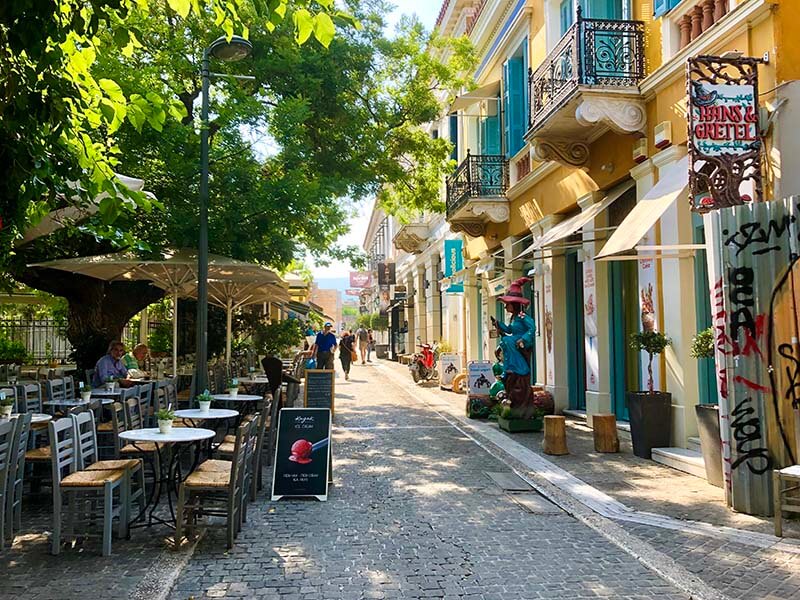

Ancient Agora
After getting settled into our apartment, our first destination is the Ancient Agora. The commercial hub and center of ancient Athens. The Agora was a large public square which hosted political, commercial and religious activities. Today, it’s more important for its historical significance than its splendor. There are some architectural remains scattered across several acres but walking through them feels more like visiting a city park than an a visit to ancient Athens.
The most notable buildings in the Ancient Agora include the Temple of Hephaestus, the best preserved Doric temple in Greece (dating back to 450 BC), and the Church of the Holy Apostles (dating back to the 10th century.) Both have survived intact since their foundation. The Stoa of Attalos is another impressive building in the Ancient Agora, but it’s a reconstruction of the original building, completed in 1950s.
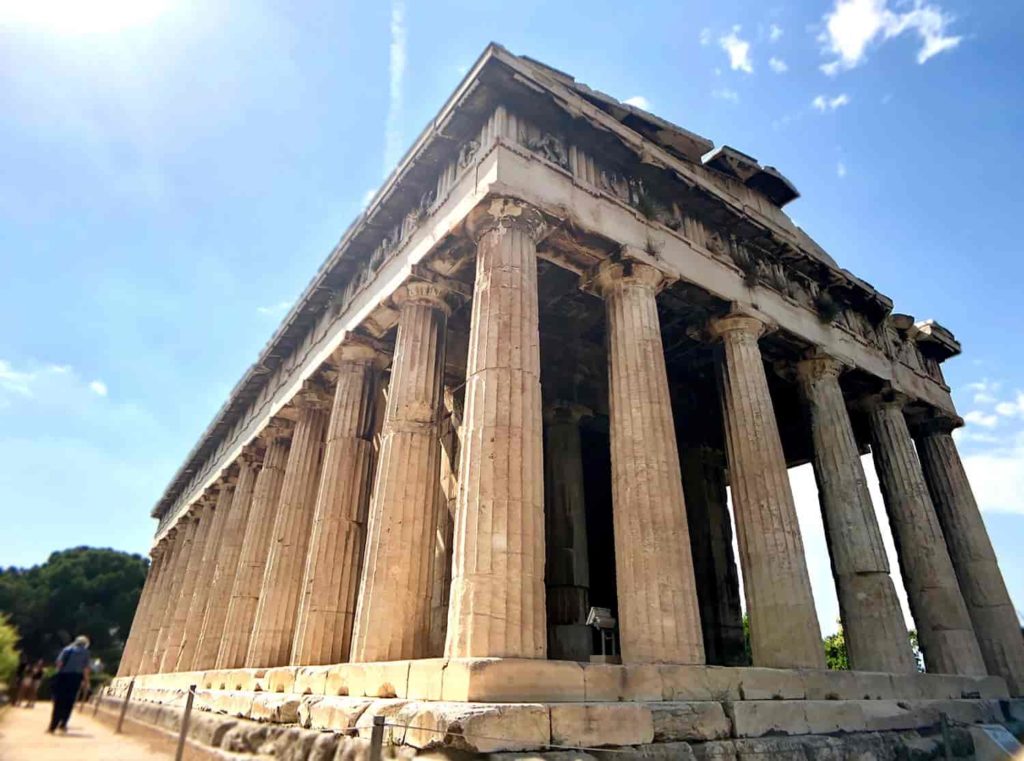

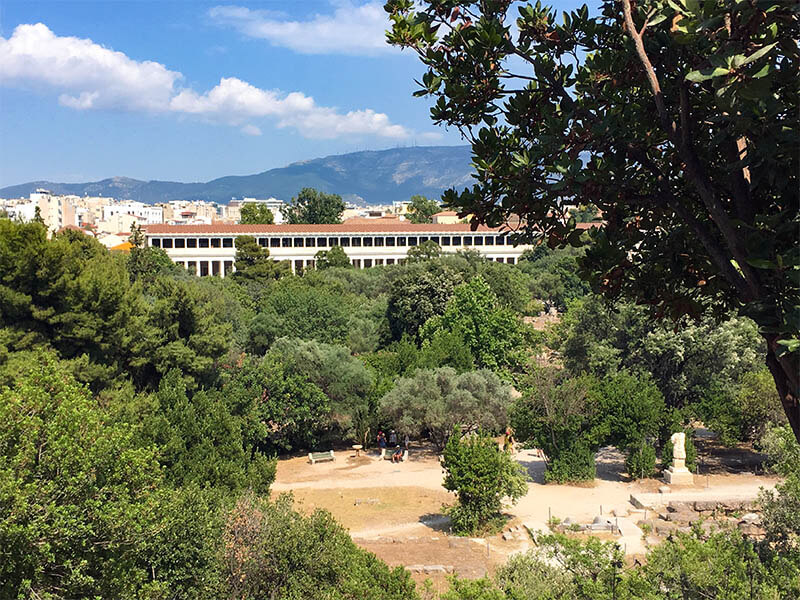
After spending the afternoon walking through Monastiraki and the Ancient Agora we were ready to find some traditional Greek food and take a break. So, we headed to Thanasis Restaurant.
Thanasis Restaurant
Countless customer reviews tout Thanasis Restaurant as having “hands-down the best souvlaki in town” (and it didn’t disappoint!) As luck would have it, it was just a 5-minute walk from apartment! (Just kidding. I planned that.) Eating souvlaki while visiting Greece is a must-do and for good reason. This traditional Greek dish of a skewered grilled meat, pita, fries and salad, quickly became one of our go-to meals in Greece. You can find it almost anywhere. My favorite was chicken, but you can order it as beef, pork or lamb.

PRO TIP: Thanasis’s reputation is no secret among tourists and locals alike. The restaurant was busy every time we walked by, but when we arrived to eat we were seated quickly and the service was great. If you’re in Athens and you’re looking for reliably good, traditional Greek food you can trust these folks who have been doing it right since 1950.
After eating we headed back toward our apartment, but made one more stop. If you know us, you know we love craft beer. Seriously, there’s no way we go through the first day of any trip without finding a cold beer (locally brewed whenever possible.) Again, as luck would have it there was a great place a few minutes walk from our apartment! (Just kidding. I planned that too!)
Beer Time!
Beertime pub/restaurant is located in the trendy Psiri neighborhood, on the edge of a bustling plaza. It has plenty of outdoor seating and an impressive beer menu with a variety of greek microbrews. I had a Corfu Beer Weiss, which was delicious. Wheat beers are my favorite so I’m a pretty strong critic. It was light-bodied, bready and had the perfect banana finish, which is always the most telling for a good wheat beer in my opinion. It was honestly my favorite beer in Greece, and unfortunately I never found it again. Craig had a Strange Brew Jasmine IPA which was off-the-charts good! Intensely hoppy, hazy and juicy.
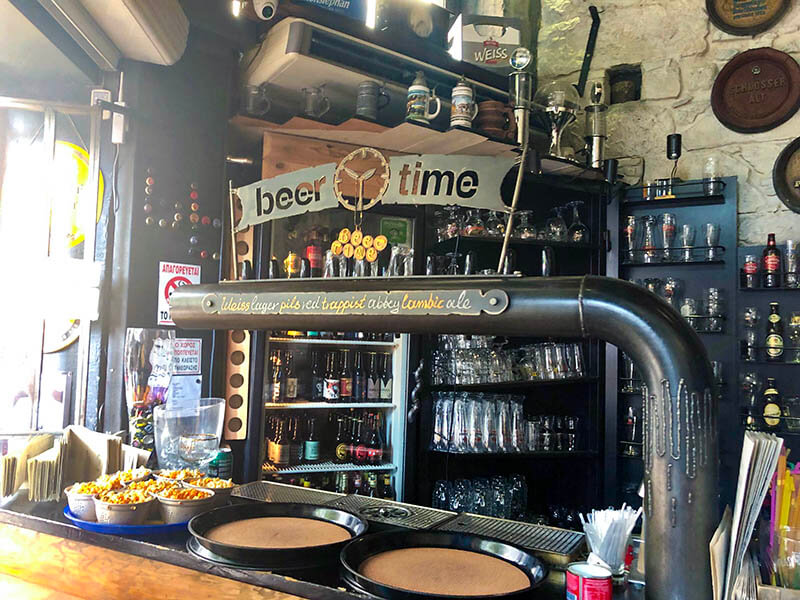

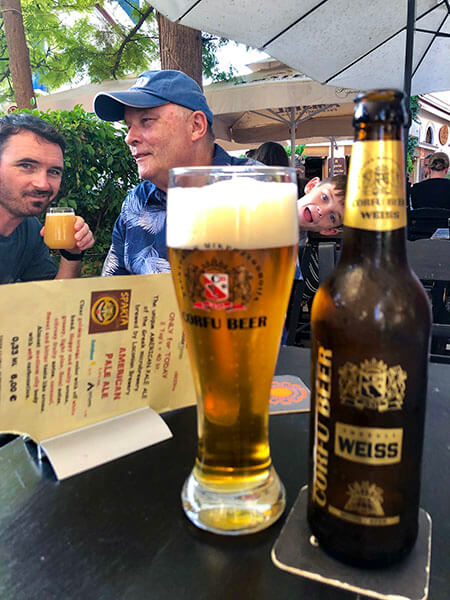
PRO TIP: If you’re like us, and you love good beer, you’ll want to stock up in Athens if you’re planning to visit other cities. You won’t find much variety elsewhere. The demand for craft beers is growing in Greece, but like most warm-weather countries we’ve visited, mass-produced lager beers are still king.
Beertime also has an American-style food menu with burgers and pizza. We’d already eaten so we didn’t order food, but looking at the plates being delivered around us, it looks like a great place to grab a bite as well!
Athens Day 2
Filopappou, Prison of Socrates, Hadrian’s Arch, Temple of Zeus, National Gardens, Tower of the Winds, Odeon of Herodes Atticus & the Acropolis at Sunset!
Sunrise in Athens is a slightly surreal experience. Watching the expanse of a modern city come to life in the shadows of ancient marble structures is an unusual phenomenon. Staring out across the city from the patio of our AirBnB, I realized that Athens is a patchwork of smaller cities. Each one unique to a specific point in history, beautifully stitched together over millennia. It’s fascinating to consider the thousands of years of history that have come and gone in this place.
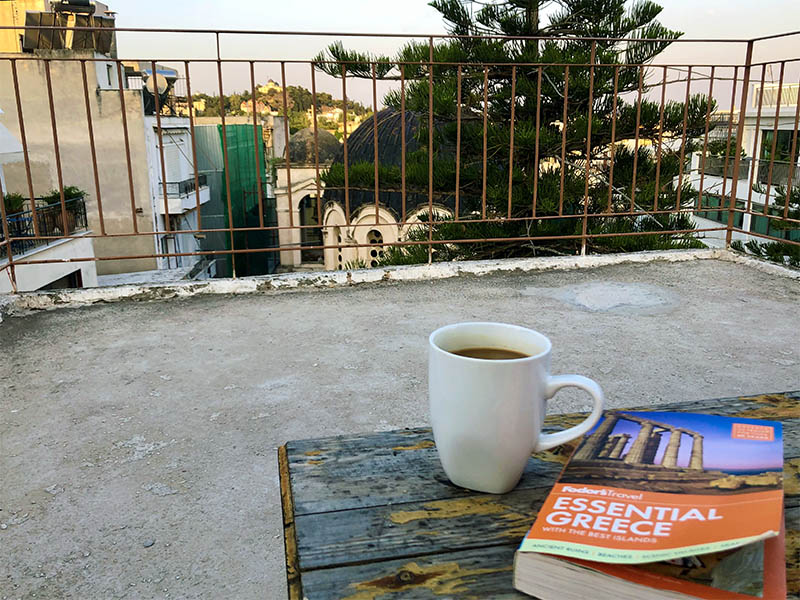
See it all! That’s our travel motto. We try to take-in as much of a place as possible, and our second day in Athens was definitely going to be a see-it-all day! Our walking itinerary makes a loop around the majority of the historic city. It seems like a lot too pack into a single afternoon, but Athens really is that walkable. All the major landmarks are really close together. We start with a hike to Filopappou, also called the Hill of the Muses, which is a summit on the southwest side of the Acropolis.
Filopappou Hill
A morning walk along the marble roads of Archaeological Site of Hills of Muses to reach the trailhead is a great way to start the day. The hike to the top of the hill is relatively easy, the path is well marked, and the views are spectacular!
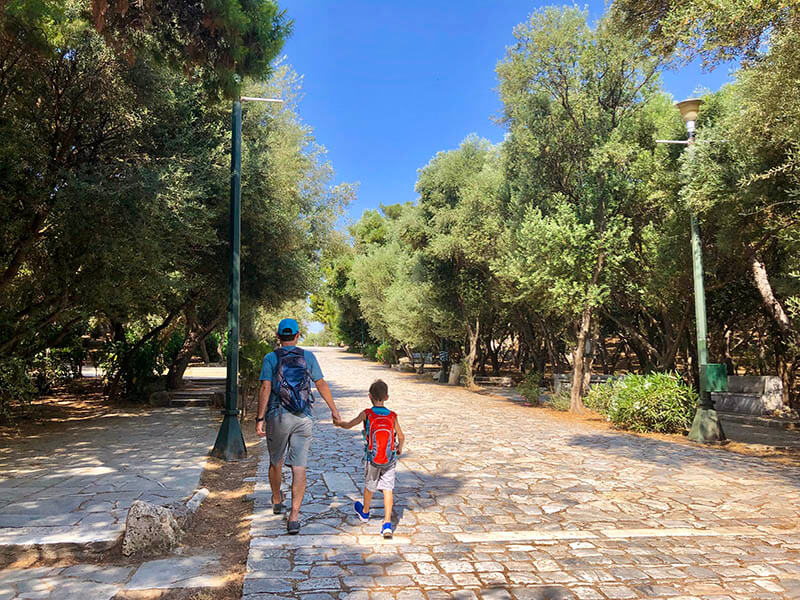
PRO TIP: Athens is HOT! The sun can be brutal in the afternoon. Get an early start on the day and be prepared. Always bring water and wear sunscreen!


Crowning the Filopappou Hill is a 40-foot high monument from 114 AD that honors Julius Antiochus Filopappos, a prominent Roman consul and administrator. But the real reason to make the climb up the hill is the view. This vantage point offers some of the best views of the city, the Acropolis, and the Aegean Sea. It’s hard to take a bad photo here. In fact, I’m pretty sure those iconic photos gracing the covers of so many guidebooks are taken here.

The Prison of Socrates
Heading back down the path there’s a detour that takes you to The Prison of Socrates. This small building carved into the bedrock of the hill is believed to be where Socrates spent the last month of his life. He was ultimately executed on charges of “corrupting the youth” in 399 B.C.

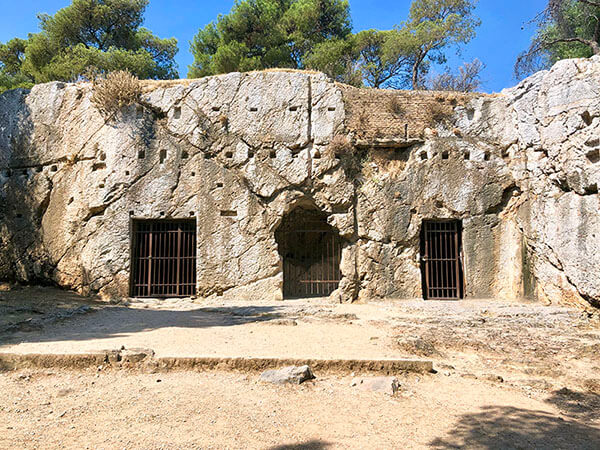
The building isn’t much of an attraction, but it’s located in a park-like setting, shaded by beautiful pine trees. And it’s a little off the beaten path so there aren’t many people around which is a plus. Just a bit further down the path there’s a solitary set of monkey bars. A pretty random location for monkey bars, but when you’re traveling with kids it’s a pleasant surprise!
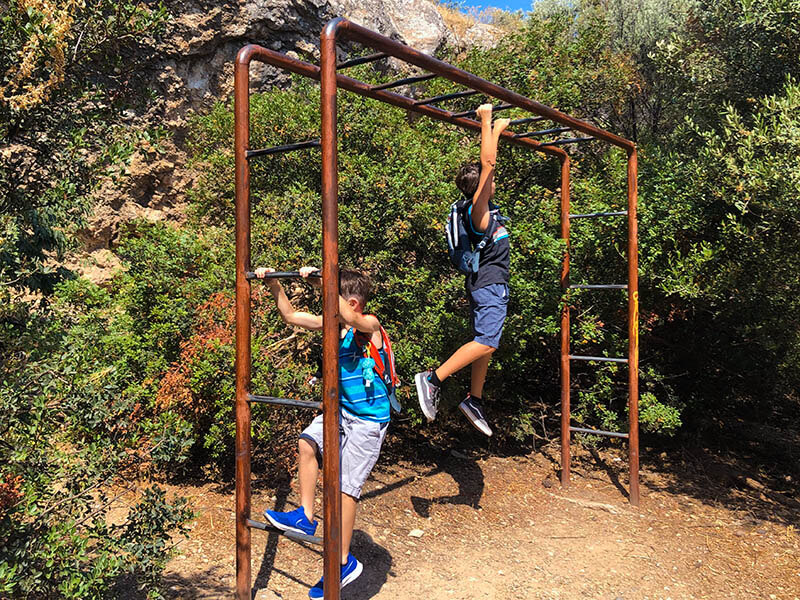
Hadrian’s Arch
Just outside the entrance of the Temple of Olympian Zeus is Hadrian’s Arch. A triumphal arch erected in 131-132 AD in honor of Roman Emperor Hadrian, a benefactor of the city of Athens. The arch once spanned an ancient road from the center of Athens to the eastern side of the city. Symbolically the arch marks the divide between the ancient Athens and Hadrian’s new city.

Temple of Olympian Zeus
Just opposite of Hadrian’s Arch is one of Athen’s grandest archeological sites. Also known as the Olympieion, the Temple of Olympian Zeus, was built by Roman Emperor Hadrian over several centuries between in 174 BC and 131 AD. Its unusually tall Corinthian columns and ambitious layout make it one of the largest temples built in the ancient world. Only 15 of the temple’s origins 104 columns are still standing. Like most ancient buildings its materials were re-used to build other projects across the city.
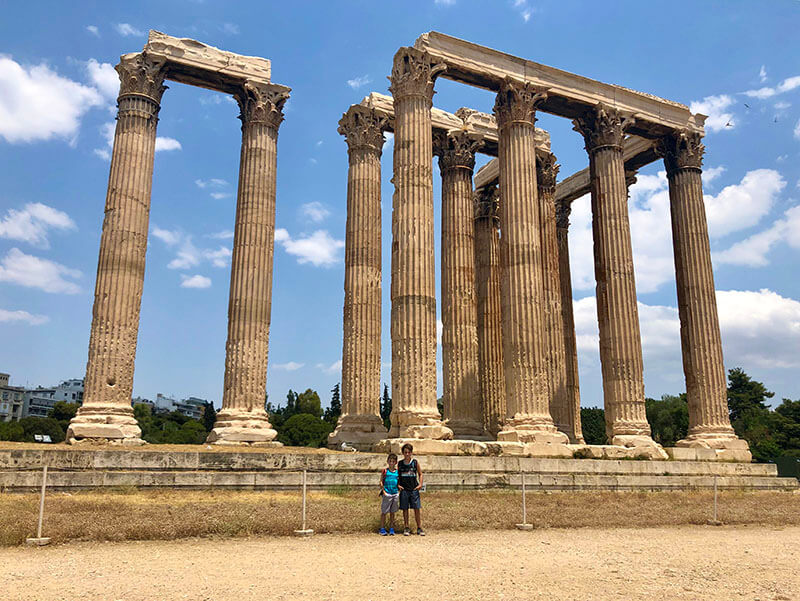
Temple of Olympian Zeus is an enormous and impressive structure, but at mid-day there’s not a slice of shade to spare you from the sun. After a few minutes admiring the height and detail of the grand columns, we snapped some pictures and headed to the National Gardens. With the sun still rising overhead and the humidity climbing, heading for the refuge one of Athen’s largest green spaces is good planning. (Knowing where to find craft beer nearby is even better planning, but I’m jumping ahead…)
National Gardens
The National Gardens are a verdant oasis in a bustling metropolis. The gardens, together with the grounds of neighboring Zappeion Hall, comprise nearly sixty acres of trees and rare plants. The canopy of the trees offer a much needed reprieve from the sun and taking time to wander along the wide paths is a great way to slow the pace, unwind, and enjoy a bit of nature. The gardens are spotted with statutes, fountains, and ponds that make for interesting stops along the way.
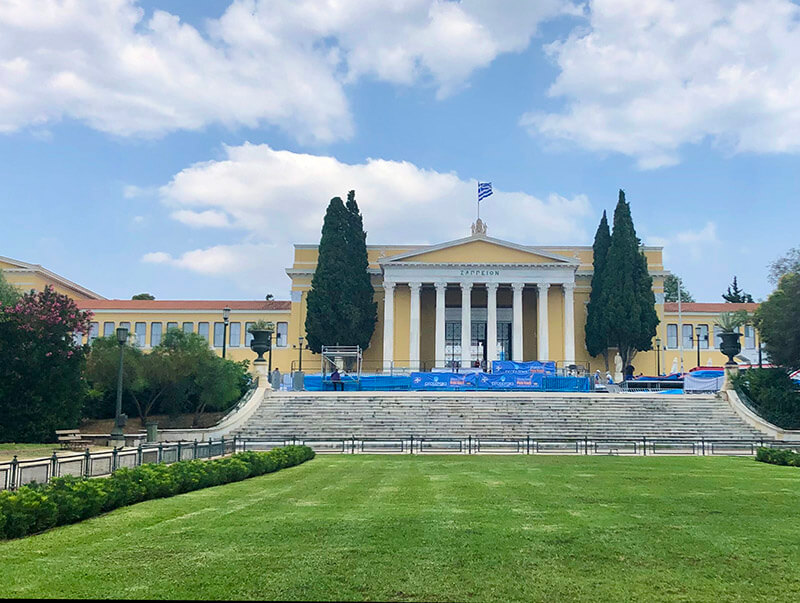
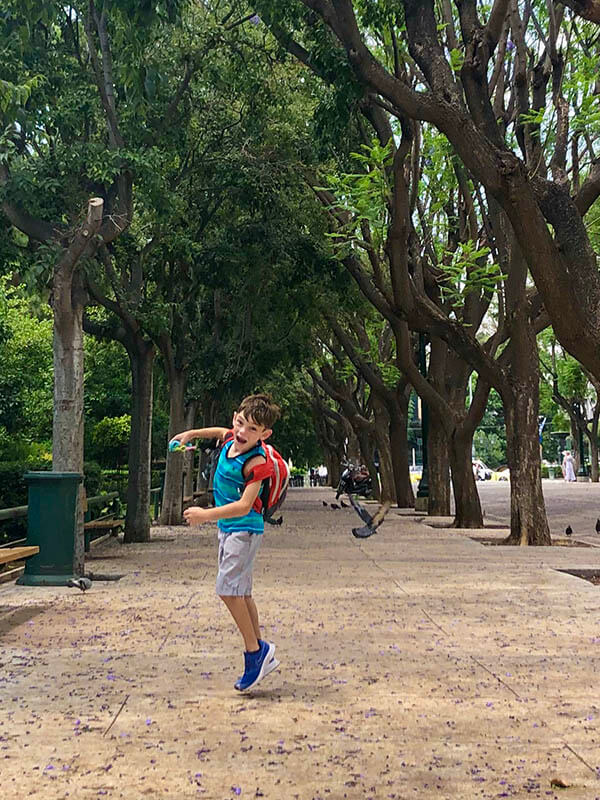
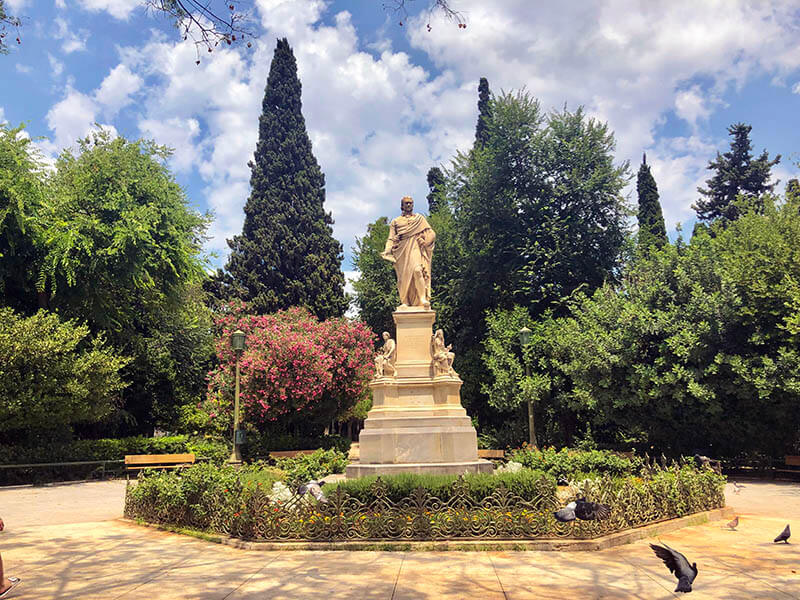
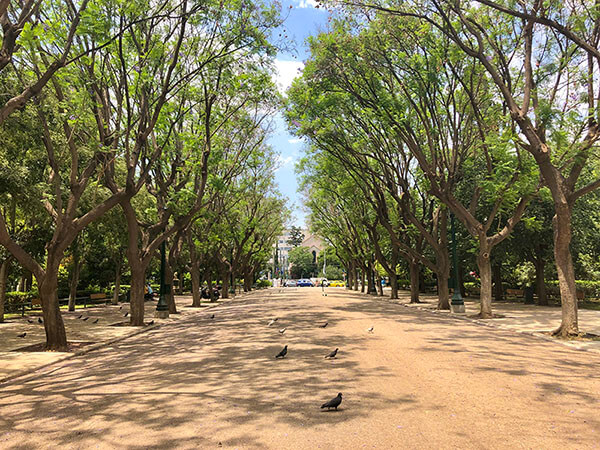
There’s only thing better on a hot Athen’s afternoon than a break from the sun… the refreshing taste of an ice cold beer! And I know exactly where to find one!
Beer Str.
Tucked into a small niche on Nikis street just outside of the entrance of the National Gardens is Beer Str. A well-stocked bottle shop offering a wide range of greek and international beers. Beer Str. is more of a take-away store than a pub, but it does have a small outdoor seating area for enjoying frosty beverages on the spot.



Kykao Wit IPA was our pick on this a particularly hot afternoon. Orange-gold with a large foamy head, it was mildly sweet, but still hoppy. And it had a lovely aroma of orange and coriander. It was exactly what we needed!
Next we head toward the heart of the city to visit the much anticipated Acropolis. The route we chose took us past the famous Tower of the Winds and the Odeon of Herodes Atticus.
Tower of the Winds
The most well-preserved Roman monument in all of Athens. Constructed around 100-50 BC the Tower of the Winds is considered the world’s first weather station. It features a combination of a sundial, a water clock, and a wind vane. Each of its eight sides represents a direction of the wind. Each side faces a point of the compass below. On the sides facing the sun are the lines of a sundial. It’s still functional and has been keeping time since the 1st century!
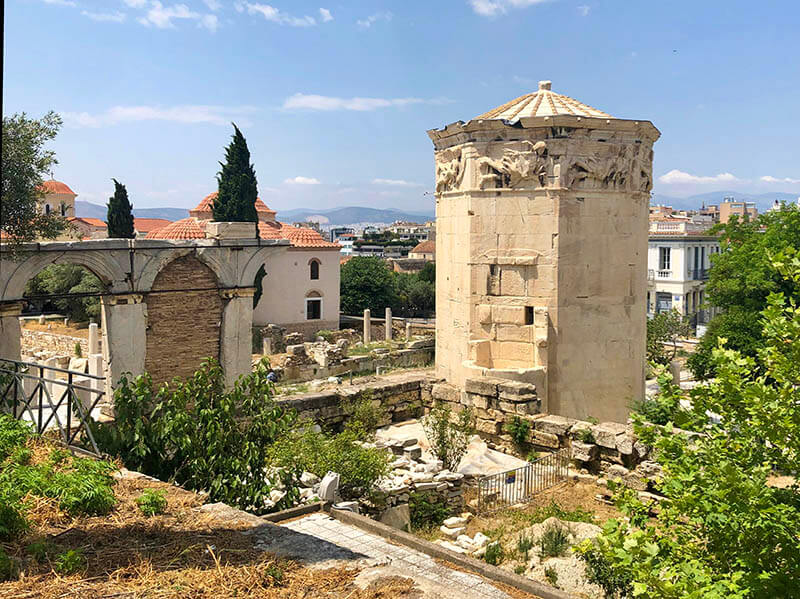
Odeon of Herodes Atticus
Set just below the slopes of the Acropolis is the beautiful Odeon of Herodes Atticus theater. Built by the affluent benefactor of Athens, Herodes Atticus, between 160 – 174 AD. The original structure was destroyed during the invasion of the Erouloi, but it was restored and reopened in 1955 as the prime location for the Epidaurus Festival. It remains an active venue for concerts, ballets and plays. You must purchase a ticket to a performance in order to go inside.

Acropolis
Definitely Athens’s most remarkable and recognizable attraction. The imposing marble structures of the Acropolis are visible from nearly every point of the city. They’re a universal symbol of Greek Antiquity.
Entering the Acropolis through the Beule’ Gate and climbing the steep stairs to the Propylaea, it’s hard to deny the swelling feeling of awe. The spiritual home of ancient heroes and gods, the Acropolis was purposefully designed to instill reverence among worshipers as they crossed from the temporal world into the spiritual world of the sanctuary. Even thousands of years later, walking through these once-sacred temples is a slightly haunting experience.

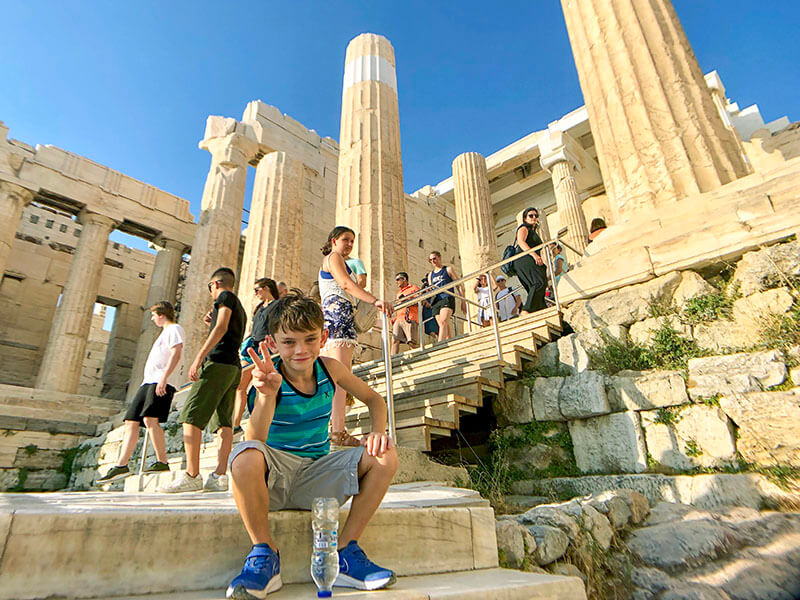

The Acropolis is most famous for the Parthenon, but it also includes several other impressive buildings. Most notable are the Temple of Athena Nike, and the Erechtheion.
PRO TIP: Plan to visit later in the day to avoid the largest crowds, and the mid-day heat, and take advantage of the last hours before sunset. Watching the sun paint the ivory columns in a golden glow is breathtaking! Definitely a unique sunset destination!
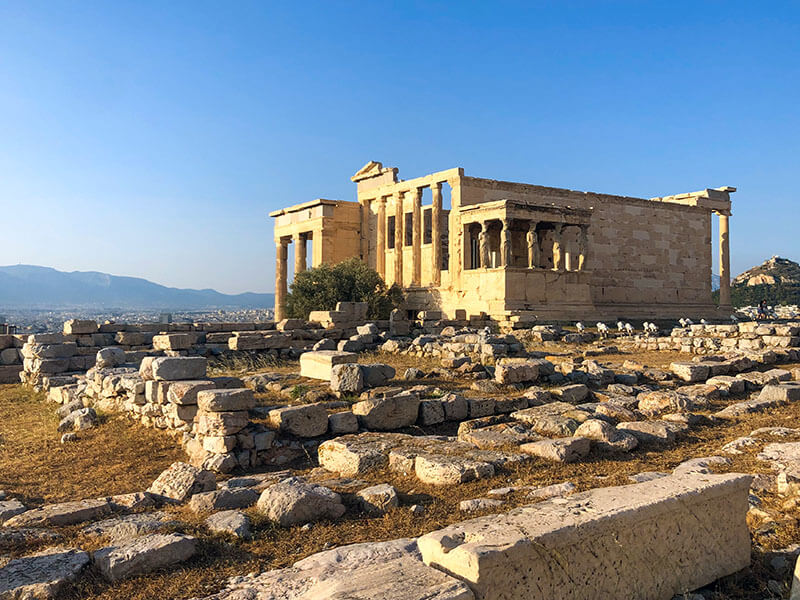
Visiting the Acropolis is a once in a life time experience. Words and pictures can’t accurately describe the beauty and grandeur of these magnificent monuments of one of history’s greatest civilizations. Making it our last stop was the perfect ending to a busy day!
Athens Day 3
Lycabettus Hill, National Archeological Museum & Shopping
From one end of the city to the other! Day three starts much like day two… with a hike. This time we head to the top of Lycabettus Hill on the opposite side of the Acropolis. At 277 meters above sea level, Lycabettus Hill is the highest point in Athens. And like Philopappos Hill it offers sensational views across the city, beyond the Acropolis to the Aegean Sea.
PRO TIP: If you’re in relatively good shape and you have the time, walking up Lycabettus Hill is the way to go. But, there is a funicular cable train that will take you to the top in about 5 minutes.
Lycabettus Hill
We love any opportunity to get outside (we prefer trees over traffic) so we took advantage of the opportunity for the easy/moderate hike to the top of Lycabettus Hill. The start of the trail is shaded and steep. It resembles a primitive staircase zig-zagging haphazardly through the woods. The stairs eventually become a gravel path, which makes for easier walking, but it keeps its relatively steep incline for the remainder of the hike. Criss-crossing up the hill, the views from the path become increasingly spectacular. The views are worth every minute of the climb.

The view from the top of Lycabettus Hill is exceptional. And there’s a small cafe with an outdoor terrace to admire the panorama while enjoying a meal, or other refreshment. For us, of course, that refreshment was an ice-cold beer. Our boys indulged with a chocolate milk.
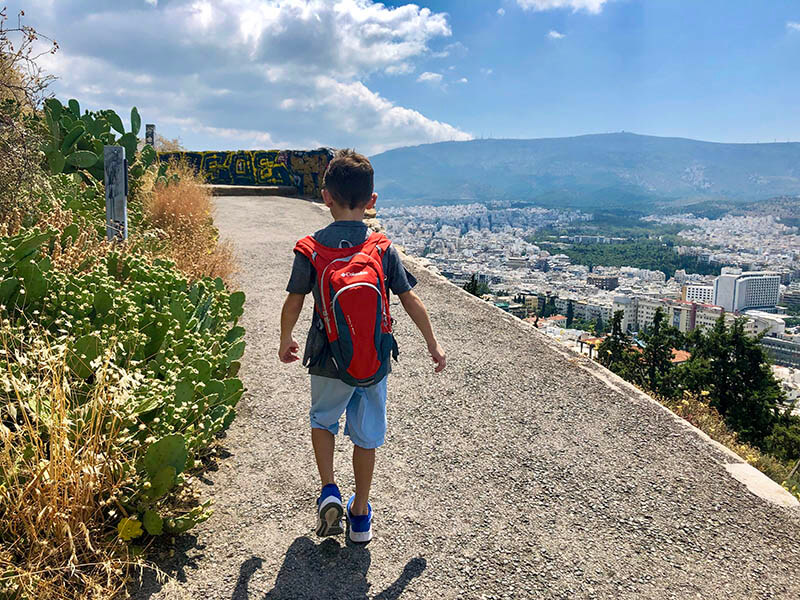
Also perched atop Lycabettus Hill is the charming St. George Greek Orthodox Church. A tiny chapel built high above the city with a traditional whitewashed exterior that contrasts beautifully against the sky. Its small, public observation deck provides a dramatic view of Athens.


After our short break at the cafe we made our way back down the hill and into the city to visit Athens’s largest museum.
The National Archaeological Museum
Considered one of the greatest museums in the world, The National Archaeological Museum contains the richest collection of artifacts from Greek antiquity. The museum is huge and has multiple galleries spread over two floors of exhibition space. There’s more than 11,000 exhibits dating back as far as the Neolithic period.
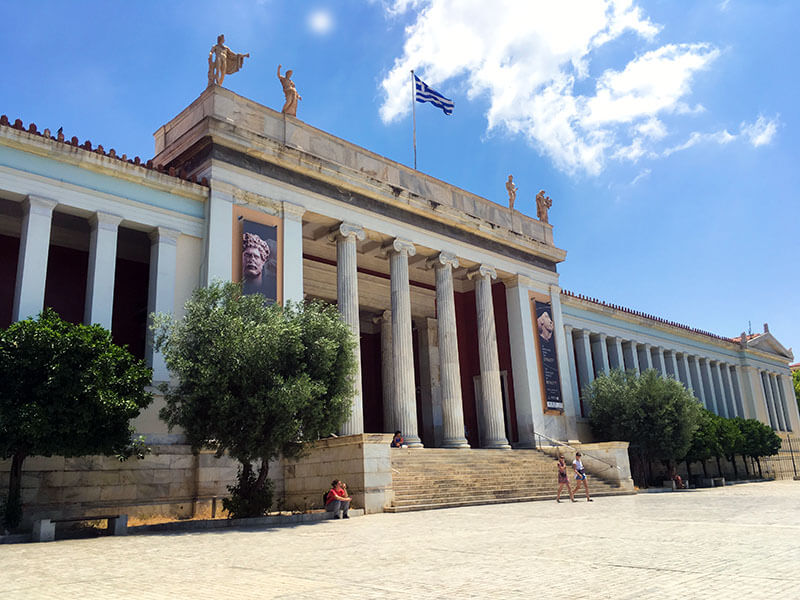
We could have easily spent half a day making our way through the vast collection of art and artifacts, but traveling with children we usually have to move quickly to see everything. That means sacrificing a lot of the reading we would do otherwise. That being said, even strolling through the many rooms and taking in a cursory understanding of what’s on display is worth the entrance fee. There is plenty of interesting and amazing things to see, even for kids.
In the case of the museum’s more famous pieces including the bronze statue of Zeus, and the Horse and Jockey (both recovered from the same shipwreck off the island of Euboea) the exceptional preservation and detail for pieces dating back to 460BC… is almost unbelievable.

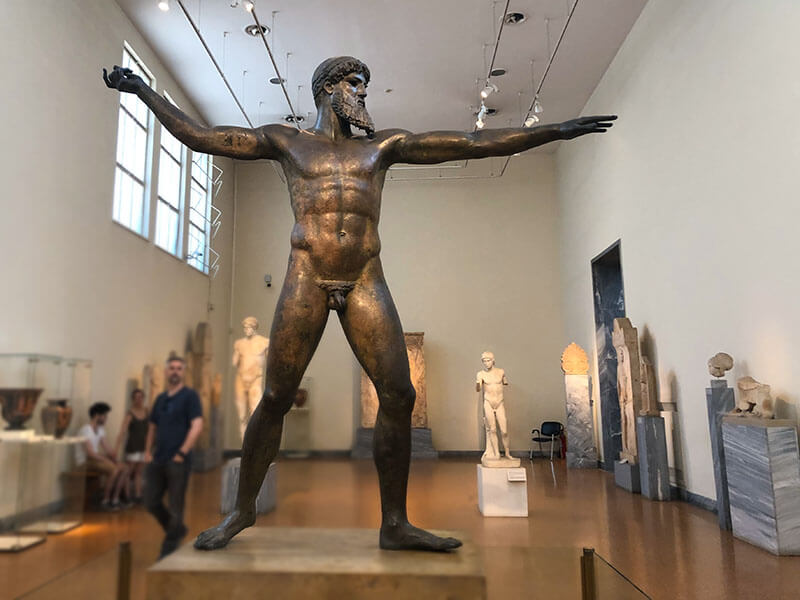
The museum also has a cafe. The menu is simple, and includes a variety of traditional greek options that are pre-cooked and ready to order. It provided a welcomed break in the museum going experience for the kids, and a much needed snack for us.
After touring the National Archaeological Museum, we let the rest of the day unfold as it would. Wandering the streets back toward the apartment, stopping at shops and markets that piqued our interest, and enjoying our last hours in Athens unscripted. Craig and I had what would be our last ‘craft’ beers in Greece and the boys finally got one of the over-sized ice cream cones they’d been admiring for days. A pretty sweet ending to our three day stay in Athens.

We Saw it All!
Having walked the city from one side to the other, climbing both the of the city’s highest peaks, visiting all the major archeological sites in between, plus the National Gardens, and the Archeological Museum, it fair to say, that with this itinerary… WE SAW IT ALL!
Athens is an excellent family destination. It’s easy to get around, safe, surprisingly affordable and packed with things to see and do.
PRO TIP: If you plan to rent a car and visit other destinations in Greece, you must have an International Drivers License. You can’t get an International Driver’s License in Greece. You must have it before you arrive.

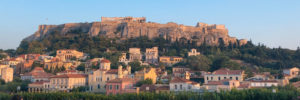
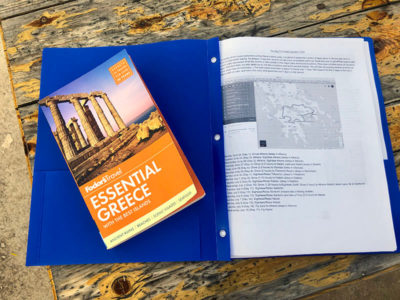
 Should You Travel to Cuba?
Should You Travel to Cuba?